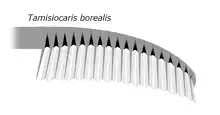
Size diagram
| Tamisiocaris Temporal range: | |
|---|---|
 | |
 | |
| Movement of a frontal appendage | |
| Scientific classification | |
| Domain: | Eukaryota |
| Kingdom: | Animalia |
| Phylum: | Arthropoda |
| Class: | †Dinocaridida |
| Order: | †Radiodonta |
| Genus: | †Tamisiocaris Daley & Peel, 2010 |
| Species: | †T. borealis |
| Binomial name | |
| †Tamisiocaris borealis Daley & Peel, 2010 | |
| Part of a series on |
| The Cambrian explosion |
|---|
 |
Tamisiocaris (from Latin tamisium, sieve, and Greek karis, crab, shrimp) is a radiodont genus initially only known from frontal appendages from the Cambrian Sirius Passet lagerstatte in northern Greenland. It was initially described initially in 2010.[1] Further study in 2014 revealed that the frontal appendages were segmented and bore densely packed auxiliary spines, which were adapted to suspension feeding in a manner analogous to modern baleen whales.[2] It is assigned to the family Tamisiocarididae, and is measured about 34 cm (1.12 ft) long in total body length.[3]
Phylogeny
Tamisiocaris in cladogram after Vinther et al., 2014.[2]
| Radiodonta |
| ||||||||||||||||||||||||||||||
References
- ↑ Daley, Allison & Peel, John S. (2010). "A possible anomalocaridid from the Cambrian Sirius Passet lagerstätte, North Greenland". Journal of Paleontology. 84 (2): 352–355. doi:10.1666/09-136R1.1.
- 1 2 Vinther, Jakob; Stein, Martin; Longrich, Nicholas R. & Harper, David A. T. (2014). "A suspension-feeding anomalocarid from the Early Cambrian". Nature. 507 (7493): 496–499. doi:10.1038/nature13010. PMID 24670770.
- ↑ Lerosey-Aubril, Rudy and Pates, Stephen (September 2018). "New suspension-feeding radiodont suggests evolution of microplanktivory in Cambrian macronekton". Nature Communications. 9 (1): 3774. Bibcode:2018NatCo...9.3774L. doi:10.1038/s41467-018-06229-7. PMC 6138677. PMID 30218075.
This article is issued from Wikipedia. The text is licensed under Creative Commons - Attribution - Sharealike. Additional terms may apply for the media files.
